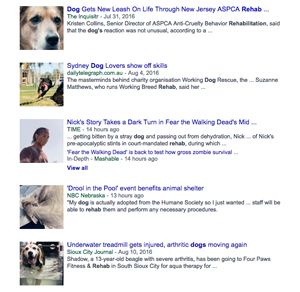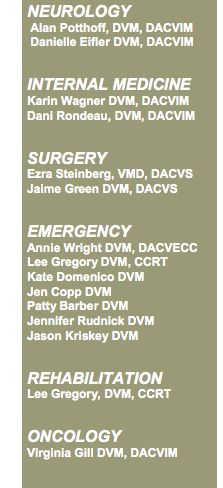10 easy ways to promote your rehab services
Do your veterinary rehabilitation service need some marketing rehab? Get in the underwater treadmill with us and we'll help flex those flabby client-acquisition muscles.
With so many different veterinary specialties cropping up, it can be hard for practitioners, let alone clients, to keep them all straight. I remember a few years ago when I heard about cold laser therapy for the first time. I couldn't help picturing veterinarians suggesting it, only to be met by blank stares and pet owners nationwide asking, “You want to laser my dog?” But marketing rehabilitation services doesn't have to be hard or confusing. The key? I spoke with several hospitals with established rehabilitation programs to find out.
Check out these 10 simple steps for how your hospital can do the same ...


These screenshots of website explanations for laser therapy include "thermal modalities" and "fibroblast production." You know what that means, but do veterinary clients? 1. Quit with the jargon
When I looked online for pet rehabilitation services, here are just a few descriptors I found on practice websites:
> "thermal modalities"
> "hydrostatic pressure"
> "viscosity"
While these terms might work great for practice staff, 50 to one they'll cause clients to scoff or ignore you. It's time to vet your language, vets. Ask a trustworthy friend from outside the industry to come along for a session (or a few). Ask each staff member to privately explain the different types of rehab services you offer and why they're important. If your friend starts to have a blank stare, it's time to simplify your staff's script. Do the same for any video or written content you create.

This practice shows off rehab services like this with real patients. (Click the photo to see the video.)2. Grab your film crew-or smartphone
I know, good video has always been a huge pain. It's expensive and time-consuming. But with mountable cameras and smartphones, it's a lot easier than it used to be, and the public's expectations of video quality are easy to meet. After all, there's a reason YouTube is the world's second-largest search engine: video works.
Plus, through your rehab program, you'll have an abundance of pets who are visibly showing improvement or doing adorable things. Even if it's just a 10-second clip of a dog sitting on a bouncy ball or a disabled kitten learning how to eat standing up, make sure you're catching those moments.
Not sure how? First, get the client's permission (here's a form). Don't be afraid to ask! Most clients love seeing their pet in the spotlight. Next, set up a camera in your rehab room, attach a mobile camera (like a GoPro) to a willing technician or vet, or hire an intern to help. From there, your resident social media guru can crop the video length down to the best 10 to 20 seconds (you can do this for free via Instagram) and post it to social media, your website-everywhere.
Don't forget: Include a brief description of who the patient is, what he's doing or why he's there and where clients can learn more about that service.
3. Exercise!
Feature an exercise your clients can do at home in a Facebook or Instagram Live post. Facebook's new Live feature allows businesses to livestream video from their page to their followers. In fact, Facebook is intentionally giving live videos increased exposure right now-something hard for brands to get without an ad spend these days. Take advantage of this increased exposure to promote your rehab services by livestreaming a pet doing an exercise your clients can try at home.
Your livestream can be a patient (with your client's permission) or the office cat your clients all know and love. Center the DIY part around a topic you know is important to them, like how to keep arthritis pain at bay or how to give your pet a massage. Clients love feeling empowered to take better care of their pets, and they'll feel just that way while they absorb some immediate value from your rehab team.
“I think Facebook's the best way to reach out to clients,” says Dara Longhini, marketing coordinator for VRC in Malvern, Pennsylvania. Longhini says Facebook is VRC's primary channel for promoting rehab services to existing clients.
PR can be a really fun department that plays very well on Facebook because most of the patients are pets on their way to recovery. People on Facebook really like to see that. I've noticed our videos and photos of physical rehabilitation patients get a lot of views.
- Dara Longhini
4. Get the FAQ out
“For people who've never met us before, the website is one of the big ways people find us,” says Krisi Erwin, DVM, CVA, CCRT, CVPP, practice owner of Wholistic Paws Veterinary Services in Hamilton, Virginia. The practice's website features a simple five-question FAQ section on pet rehabilitation that's written in plain-speak and brings traffic to the site from search engines.
I tried to make the website as comprehensive as possible. When clients call us, it can be hard for them to talk about their own situation. I wanted to give them the ability to learn as much as possible without having to pick up the phone.
- Krisi Erwin, VM, CVA, CCRT, CVPP

A recent Google Alert for "dog rehab." 5. Point the finger at others (in a nice way)
Until now, we've talked a lot about original content, but there's also plenty of great information about physical rehabilitation for pets being published every day. This is content you can link to from your website, share on social media every week and even feature in your practice newsletter-and you don't have to scour Google every hour to find it. Set up a free Google Alert for terms like “dog rehab” or “cat rehab” and have relevant news stories delivered to your inbox daily or weekly.
Once the alert is set up, you can review everything that's been recently published on the subject in one sitting, pick your favorites and share them with your clients on Facebook. Then your social media expert can track which stories reach the most people so you can link to them from your e-newsletter each month.

Facebook post announcing a veterinary practice weight loss content.6. Sneak it in with the season
There are certain seasonal topics we talk about year in, year out: winter care, parasite prevention, heat safety, etc. Instead of sharing the same old tips, think about how you can make them new again with a focus on physical rehabilitation. Is your practice planning a communication about winter weather? Include a few rehabilitation tips for helping arthritic pets in the cold. Are you planning an end-of-summer event for clients? Think about doing a hydrotherapy pup party at your local pool before it closes for the season.
Wizard of Paws Physical Rehabilitation for Animals in Colchester, CT, takes timely education to another level with special challenges that play off popular culture.
“The Biggest Loser is our fun contest to help owners help their dogs lose weight,” says Wizard of Paws owner Debbie Gross, DPT, MSPT, DABPTS, CCRP. “It also helps referring veterinarians to send their clients in for a weight loss solution they can take ownership in.” Both dogs and their owners can receive prizes for achievements.

Every specialist, every time gets into the practice e-newsletter at Maine Veterinary Referral Center in Scarborough, Maine.7. Reminder: Use reminders
OK, this might seem like a no-brainer, but it's an important one. Even if you see every sign, staff script, on-hold recording, brochure, email newsletter and social media post that goes out (ha!), that doesn't mean your clients do. In fact, they're probably missing or tuning out about 90 percent of it all, so frequent reminders about what services are available are necessary. Care First Animal Hospital in Raleigh, North Carolina, keeps signs, brochures and other items around the clinic to be sure visiting clients know that rehab services are available. Maine Veterinary Referral Center in Scarborough, Maine, includes all the specialties in the prominent sidebar on the first page of every quarterly newsletter.
8. Spend just a little on social media advertising
If you're already creating great videos and social media or website content about your rehabilitation services, consider spending a little for targeted ads to get your hard work the attention it deserves. The budget can be small-as little as $1 per day-and you can limit who sees your promotion (for example, women ages 35-54 who like senior or special-needs dogs). This is a great next step after really ramping up your interactions using the first three tips on this list.

Practice owner Krisi Erwin, DVM, CVA, CCRT, CVPP, talked up pets at a local speaking gig and got new clients out of the deal.9. Get in their faces
Whether it's a puppy/kitten kindergarten class or a panel discussion on living with senior pets, after-hours seminars put you and your practice front and center in potential clients' minds. Wholistic Paws Veterinary Services recently saw new clients come to the practice after a seminar on aging pets. The practice also regularly gives talks to local rescues and dog trainers.
10. Build a nice network
Whether your practice is a general one that's added a specialty or an exclusive specialty referral center, helping other area practice owners and teams understand the benefits of what you offer to their patients might be the most important way to gain new clients for your rehab services.
Each of the practices I spoke with for this article were doing local outreach to pet health professionals. As Longhini from VRC says, “Many referring veterinarians haven't had much experience with up-and-coming techniques like e-stim, therapeutic ultrasound, hydrotherapy and cold-laser therapy."
Every practice I spoke to also put special importance on keeping those referring veterinarians involved in ongoing care. You can't guarantee local colleagues won't see your new rehab service as a threat to their bottom line, but you can always do what you can to show them the benefits of the service to pets and guarantee you'll send them back to their practice home for anything but rehab.
Jane Harrell is president of ‘cause Digital Marketing. She previously served as Head of Pet Owner Communications for IDEXX Laboratories and Senior Producer for Petfinder.com.